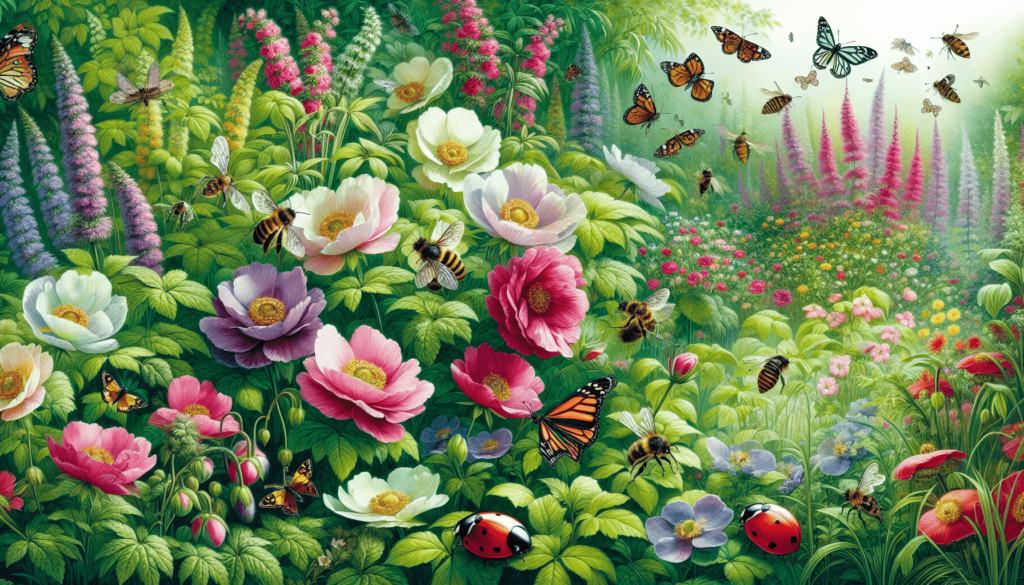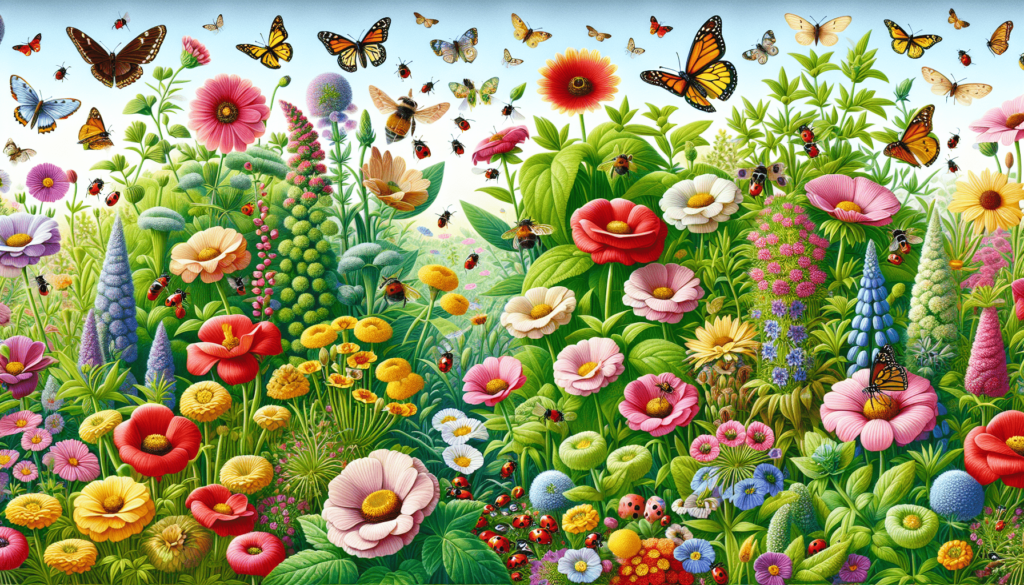Looking to create a vibrant and thriving garden? Look no further than the power of beneficial insects! In this article, we will share with you the secret to attracting these helpful critters – the best plants! By carefully selecting the right plants for your garden, you can coax these benefactors to visit, bringing with them a natural pest control system and a boost to your garden’s overall health. So, let’s explore an array of beautiful and captivating plants that will make your garden an irresistible haven for beneficial insects.

Importance of Beneficial Insects
Understanding beneficial insects
Beneficial insects play a crucial role in maintaining the equilibrium of our ecosystems. These insects provide important services such as pollination and natural pest control, which are essential for the health and sustainability of our gardens and agricultural systems. In order to fully appreciate the significance of beneficial insects, it is important to understand their role and the benefits they bring to our environment.
Role in pest control
One of the key roles of beneficial insects is their ability to control pests naturally. These insects act as biological control agents by preying on or parasitizing pests that can harm our plants. By introducing and attracting beneficial insects to our gardens, we can reduce or even eliminate the need for chemical pesticide applications. This not only helps protect our plants from damage but also prevents the negative impacts of pesticides on the environment and human health.
Overall ecosystem importance
Beneficial insects are not only important for pest control but also play a vital role in maintaining the overall health of our ecosystems. They contribute to the balance of predator-prey relationships, support pollination processes, and provide food for other organisms. Without these beneficial insects, our ecosystems would become imbalanced, leading to a decline in biodiversity and the disruption of important ecological processes.
Factors to Consider when Choosing Plants
Native plants vs. introduced species
When selecting plants for your garden, it is important to consider whether they are native to your area or introduced species. Native plants are well adapted to the local climate and soil conditions, making them more likely to attract and support beneficial insects. Introduced species, on the other hand, may not provide the same level of support for beneficial insects and could even become invasive, disrupting the native ecosystem.
Plant diversity and flowering period
Plant diversity is key when it comes to attracting a wide range of beneficial insects. Different insects have different preferences when it comes to food sources, so having a variety of plants with varying flowering periods can ensure a continuous supply of nectar and pollen throughout the year. This will attract and sustain a diverse population of beneficial insects in your garden.
Compatibility with local climate and soil conditions
It is important to choose plants that are well-suited to the climate and soil conditions in your area. Plants that are not well adapted may struggle to thrive, reducing their ability to attract beneficial insects. By selecting plants that are compatible with the local environment, you can create an ideal habitat for beneficial insects to thrive.
Sun and shade requirements
Consider the sun and shade requirements of the plants you choose. Some beneficial insects prefer sunny areas, while others thrive in the shade. By providing a mix of sunny and shaded areas in your garden, you can attract a greater variety of beneficial insects.
Attractiveness to specific beneficial insects
Different beneficial insects are attracted to different types of plants. For example, ladybugs are attracted to plants with small, clustered flowers, such as dill and yarrow, while lacewings are drawn to plants with tiny, tubular flowers like alyssum. Research the specific preferences of the beneficial insects you want to attract and select plants that are known to be attractive to them.
The Best Plants for Attracting Beneficial Insects
Dill
Dill is not only a culinary herb but also an excellent plant for attracting beneficial insects. Its tiny flowers are especially attractive to ladybugs and hoverflies, which are known to be voracious predators of aphids. By planting dill in your garden, you can encourage these beneficial insects to take up residence and keep harmful aphid populations under control.
Sunflowers
Sunflowers are not only a vibrant addition to any garden but also a magnet for beneficial insects. Their large, showy flowers with abundant pollen and nectar attract a wide range of beneficial insects, including bees, butterflies, and even predatory wasps. By planting sunflowers, you can create a haven for these helpful insects and enhance the natural balance of your garden.
Yarrow
Yarrow is a hardy perennial plant that is known for its feathery foliage and clusters of tiny flowers. It is highly attractive to beneficial insects such as ladybugs, lacewings, and parasitic wasps. These insects prey on common garden pests like aphids, thrips, and caterpillars. By including yarrow in your garden, you can provide a food source and habitat for these beneficial insects, allowing them to thrive and help keep your plants pest-free.
Purple Coneflower
Purple coneflower, also known as Echinacea, is a beautiful flowering plant that is not only a favorite of gardeners but also a favorite of many beneficial insects. Its large, daisy-like flowers provide ample nectar for bees, butterflies, and other pollinators. Additionally, the seed heads of the coneflower are a valuable food source for birds, attracting even more beneficial wildlife to your garden.
Alyssum
Alyssum is a low-growing flowering plant that is well-loved by many beneficial insects. Its small, tubular flowers release a sweet fragrance that is particularly attractive to lacewings and hoverflies. These insects are important predators of aphids and other small pests. By planting alyssum in your garden, you can create an enticing environment for these beneficial insects and benefit from their pest-control services.
Fennel
Fennel is not only a delicious herb but also a beneficial insect magnet. Its feathery foliage and large, umbrella-like flower clusters provide shelter and nectar for a variety of beneficial insects, including ladybugs, lacewings, and parasitic wasps. By including fennel in your garden, you can provide a reliable food source for these beneficial insects and encourage them to help keep your garden pest-free.
Calendula
Calendula, also known as pot marigold, is a bright and cheerful flowering plant that is highly attractive to a wide range of beneficial insects. Its bright orange and yellow flowers produce abundant nectar, making them a favorite of bees, butterflies, and even predatory wasps. By planting calendula in your garden, you can create a vibrant and beneficial habitat for these important insects.
Goldenrod
Goldenrod is a native perennial plant that is highly beneficial to a variety of insects. Its tall, yellow flower spikes provide a rich source of pollen and nectar, attracting bees, butterflies, and other pollinators. Additionally, goldenrod is also a favorite food source for many beneficial insects, such as ladybugs and lacewings, which prey on aphids, thrips, and other garden pests. By incorporating goldenrod into your garden, you can support a diverse ecosystem of beneficial insects.
Lavender
Lavender is not only prized for its beautiful fragrance but also for its ability to attract beneficial insects. Its purple flowers are particularly attractive to bees and butterflies, making lavender an important plant for pollinators. Additionally, lavender’s strong scent deters pests such as mosquitoes and moths, creating a natural pest barrier in your garden. By planting lavender, you can create a fragrant and beneficial oasis for both insects and humans alike.
Milkweed
Milkweed is a critical plant for attracting beneficial insects, especially monarch butterflies. The leaves of milkweed serve as a food source for monarch caterpillars, while the flowers provide nectar for adult butterflies and other pollinators. By including milkweed in your garden, you can support the survival of monarch butterflies and contribute to the conservation of this iconic species.
Additional Considerations for Planting
Companion planting for insect diversity
Companion planting involves growing different plant species together in order to enhance the growth and health of both plants. When it comes to attracting beneficial insects, companion planting can be a powerful tool. By interplanting a mix of plants that have complementary characteristics, such as attractive flowers, diverse foliage, and different heights, you can create a multi-layered garden that attracts a wide range of beneficial insects and supports a diverse ecosystem.
Providing water sources
Just like any other creature, beneficial insects need water to survive. Providing a water source in your garden, such as a shallow dish filled with water or a small pond, can greatly enhance its attractiveness to beneficial insects. Be sure to regularly refill the water source and provide perching areas such as rocks or twigs to make it easily accessible for the insects.
Minimizing pesticide use
In order to attract and sustain beneficial insects in your garden, it is important to minimize the use of chemical pesticides. These pesticides can be harmful not only to pests but also to beneficial insects and other wildlife. Instead, consider using organic pest control methods, such as handpicking pests, using insecticidal soaps, or encouraging natural predators. This will help maintain a healthy balance in your garden and promote the presence of beneficial insects.
Regular maintenance and monitoring
To ensure the ongoing success of your beneficial insect habitat, it is important to regularly maintain and monitor your garden. This includes removing any dead or diseased plants, managing weeds, and providing appropriate care for your plants. Regular monitoring will allow you to identify any potential issues early on and take necessary measures to address them, ensuring that your garden remains a thriving haven for beneficial insects.

Benefits of Attracting Beneficial Insects
Natural pest control
By attracting beneficial insects to your garden, you can rely on natural pest control methods rather than relying on chemical pesticides. Beneficial insects act as natural predators of common garden pests, such as aphids, caterpillars, and mites. They help keep pest populations in check, preventing damage to your plants and reducing the need for harmful chemical interventions.
Pollination support
Many beneficial insects, such as bees and butterflies, are important pollinators. By attracting these insects to your garden, you can promote pollination and enhance the productivity of your plants. Improved pollination leads to higher yields of fruits, vegetables, and flowers, ensuring a bountiful harvest and a beautiful garden.
Promotion of biodiversity
Attracting a diverse array of beneficial insects to your garden promotes biodiversity. By providing the right plants and habitats, you can support a wide range of insect species, each with its own unique role in the ecosystem. This diversity fosters a healthy and resilient environment, making your garden more sustainable and resilient to pest outbreaks and other disturbances.
Reduced reliance on chemical pesticides
By creating a garden that attracts beneficial insects, you can reduce your reliance on chemical pesticides. This not only benefits the environment but also protects the health of humans and other animals. Chemical pesticides can have harmful effects on non-target organisms and can accumulate in the environment, leading to long-term damage. By relying on natural pest control through beneficial insects, you can minimize these negative impacts and create a safer and more sustainable garden.
Conclusion
Attracting beneficial insects to your garden is not only beneficial for your plants but also for the overall health and sustainability of the ecosystem. By understanding the importance of these insects and selecting the right plants, you can create an inviting habitat that supports a diverse range of beneficial insects. By providing a continuous supply of food, water, and appropriate habitats, you can encourage beneficial insects to thrive and help maintain the balance of nature in your garden. So start planting those dill, sunflowers, yarrow, purple coneflower, alyssum, fennel, calendula, goldenrod, lavender, and milkweed, and reap the rewards of a vibrant and thriving garden filled with beneficial insects.

